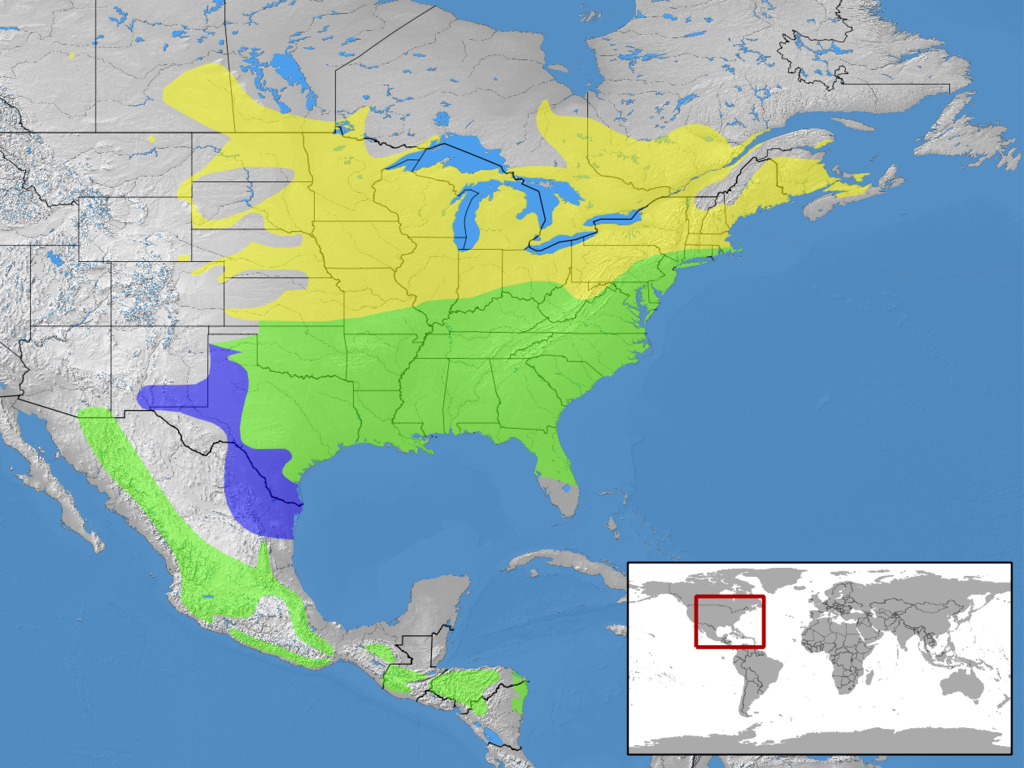This species measures 16–21 cm (6.3–8.3 in) long, spans 25–32 cm (9.8–12.6 in) across the wings, and weighs 27–34 g (0.95–1.20 oz).[3][4] Eastern bluebirds are found east of the Rockies, southern Canada to the Gulf states, and southeastern Arizona to Nicaragua. The increase in trees throughout the Great Plains during the past century due to fire suppression and tree planting facilitated the western range expansion of the eastern bluebird[5] as well as range expansions of many other species of birds.[6][7][8] From 1966-2015 the eastern bluebird experienced a greater than 1.5% annual population increase throughout most of its breeding and year-round ranges, with exceptions including southern Florida and the Ohio River valley.[9]
The bright-blue breeding plumage of the male, easily observed on a wire or open perch, makes this species a favorite of birders. The male's call includes sometimes soft warbles of 'jeew' or 'chir-wi' or the melodious song 'chiti WEEW wewidoo'.[10]

Food
About two-thirds of the diet of an adult consists of insects and other invertebrates. The remainder of the bird's diet is made up of wild fruits or berries. Favored insect foods include grasshoppers, crickets, katydids, and beetles. Other food items include earthworms, spiders, millipedes, centipedes, sow bugs, and snails.
Male
Life history
Eastern bluebird in Huntley Meadows Park in Virginia
Both parents cooperate in raising the young, which they feed a diet consisting almost entirely of insects. Some young stay around the nest to help raise another brood. Fledglings are grayish in color, with speckled breasts. The blue color becomes much more prominent and the speckles on their breasts disappear as they mature. Bluebirds may begin breeding the summer after they are hatched.[4]
Eastern bluebirds can live for 6 to 10 years. The longest recorded lifespan for a bluebird is 10 years and five months.[11] However, most bluebirds die within their first year of life. Starvation and freezing are a danger to the young, but most threats come from other animals, including humans. Natural predators of eggs and nestlings can include eastern chipmunks, flying squirrels, American black bears, fire ants, and raccoons. Bluebirds of all ages (including adults) are threatened by rat snakes, racers, American kestrels, and domestic cats. Introduced species such as European starlings and house sparrows are competitors for nesting sites. Non-nesting adults face predation by all native species of falcons, owls, and most varieties of hawks, particularly those in the genus Accipiter. When approached by a predator, the male makes a song-like warning cry. If no male is present, a threatened female will begin to sing, hoping to attract a protective male back to the territory. Both males and females also flick their wings and warble when predators are nearby.[4]
Habitat
Eggs




No comments:
Post a Comment
Note: Only a member of this blog may post a comment.